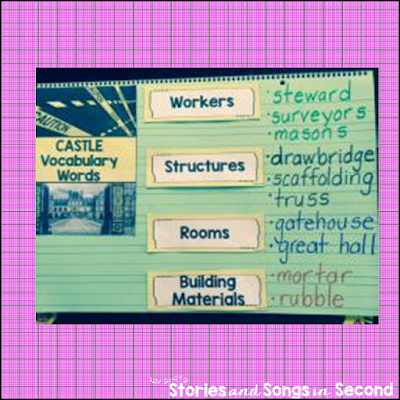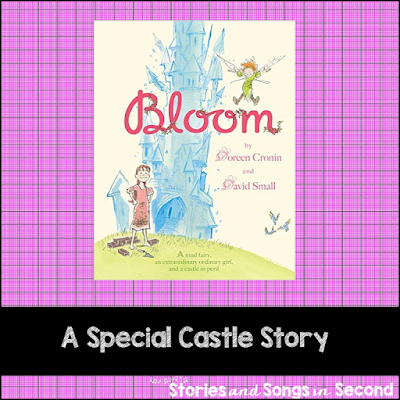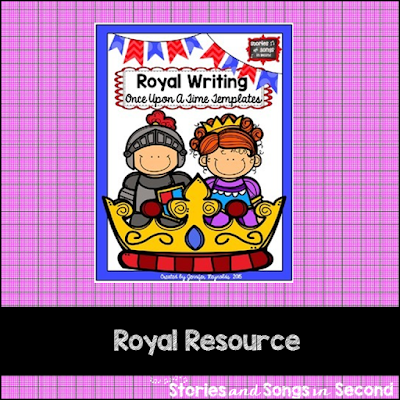This blog post was previously published over at Minds in Bloom as a guest feature about five years ago. It is no longer active on the site, so I thought I would re-share it here! It highlights one of my favorite lessons that integrates S.T.E.A.M. and literacy learning! Enjoy!
CASTLES UNDER CONSTRUCTION:
FULL S.T.E.A.M. AHEAD!
Fairy Tale Research
My class became fascinated with castles in March when one of our Scholastic News magazines featured photographs and diagrams of one ancient building in Ireland. The article text described what daily royal life would have been like back in 1228, labeled the main architectural features of Bunrathy Castle, and introduced us to a myriad of wonderful vocabulary words like battlement, finial, truss, and wattle,
CASTLE RESEARCH STUDY
This non-fiction text study sparked great curiosity and lots of questions from my little learners, so we used David Macaulay's Castle picture book and excerpts from his PBS documentary to research and learn more about these historic, intricate structures.
CASTLE LITERATURE LINKS
CASTLE VOCABULARY
After completing our research study and virtual field trip, we enjoyed Walter Wick's
Can You See What I See? Once Upon A Time together, connecting what we'd learned about real castles to what we observed about the castles featured in fairy tales we'd read about or seen in movies. We wandered through the whimsical photo puzzles on each page, looking for the hidden objects listed, and comparing and contrasting the castles depicted in The Little Mermaid, Cinderella, Sleeping Beauty and Puss in Boots.
Next, I shared photos of castles found around the world to help my students learn about France, England, and Germany, three countries where many traditional fairy tales originated. After we discussed how each castle example was different in size, shape, structure, and design, we plotted the picture "postcards" on our world map to tie-in with our current Social Studies unit. We then headed upstairs to visit our 5th grade buddies and to use their Chromebooks for Internet research. Together we surfed the web for other pictures of castles and looked for the three-dimensional figures we'd learned about in our recent geometry lessons "hidden" in the architecture of the castles.
The room was abuzz with "Math talk" as they spied turrets shaped like cylinders, tower roofs shaped liked cones, and drawbridges shaped like rectangular prisms! There was great joy and wonder among the group when Minecraft and Disney castles came up in their Google searches. The discovery of Frozen-like ice castles created for a winter festival in Edmonton, Canada caused quite a stir of excitement as well!
Can You See What I See? Once Upon A Time together, connecting what we'd learned about real castles to what we observed about the castles featured in fairy tales we'd read about or seen in movies. We wandered through the whimsical photo puzzles on each page, looking for the hidden objects listed, and comparing and contrasting the castles depicted in The Little Mermaid, Cinderella, Sleeping Beauty and Puss in Boots.
CASTLES AROUND THE WORLD
Fairy Tale Mapping and 3-D Shape Scavenger Hunt
SHAPE SCAVENGER HUNT
The room was abuzz with "Math talk" as they spied turrets shaped like cylinders, tower roofs shaped liked cones, and drawbridges shaped like rectangular prisms! There was great joy and wonder among the group when Minecraft and Disney castles came up in their Google searches. The discovery of Frozen-like ice castles created for a winter festival in Edmonton, Canada caused quite a stir of excitement as well!
EXPLORING FAIRY TALES
After a lengthy discussion of these traditional castles--and how most were made of sturdy stone and designed to be safe, protective fortresses--I introduced Doreen Cronin's picture book, Bloom. This fairy tale has a modern-twist features and features a non-traditional castle built of glass, a fairy who prefers mud instead of pixie dust, and an ordinary servant girl who turns out to be extraordinarily intelligent, independent, and heroic.
Before I read Bloom aloud, my class previewed the illustrations and brainstormed lists of suitable and non-suitable castle construction materials. After discussing the pros and cons of each one, we charted our predictions about what problems the royal family living in a castle made of glass might have to deal with, and discussed how more practical materials might solve those problems. My favorite student observations follow:
"You would not have any privacy if you lived in a house made of glass! Everyone could see inside!"
"A castle of glass would not be very safe! Enemies could just throw rocks and break through the walls!"
"The king and queen should have used stone for the walls of their castle! They were not very smart!"
"If the glass ever shattered, everyone inside would get hurt badly!"
Now, you are probably wondering, where are the S.T.E.A.M. elements of this fairy tale study? Never fear! They are right here! After problem-solving and becoming castle "experts," it was time for my students to try our hand at constructing castles of our own!
Fairy Tale Castle Construction
As the "Ruler of Room #2," I set up several different "kingdoms" of Math manipulatives that I had pulled from my storage cupboards and those of my colleagues. Students were then asked to organize themselves into groups of scientists, technicians, engineers, artists, and mathematicians for each one. I then issued a "royal decree" calling for these "S.T.E.A.M Teams" to use the shape-based supplies I'd provided to construct model castles for "Queen Reynolds." I put on my sparkly tiara, set the timer for 15-minutes, waved my royal scepter to remind them that the materials were "tools not toys," and directed my "royal builders" to get busy! When time was up, I snapped proud pictures of their creative efforts before each team rotated to a new "Imagination Station." Our foam solids, pattern blocks, wooden blocks, and attribute blocks were used creatively and thoughtfully to build unique architectural masterpieces that made my heart happy! Some of the favorite comments and learning connections I overheard while our 3-D castles were under construction follow:
"We need to make sure we design our castle so it is protected! Too bad we don't have anything to make a pulley for the drawbridge to go up and down!"
"I think we should stack the cylinders on top of each other! They will support the cones we're using to make the rooftops of the lookout tower!"
"These rectangular prisms can lay side-by-side to create the wall around the castle courtyard."
"Look at how we can stack these cubes to create the castle entrance! Too bad we don't have any mortar to hold them together like the real castle builders had!"
The next step in our integrated, cross-curricular project is for my students to join forces with their 5th grade buddies to create castles out of recycled, real-life three-dimensional solids. I just sent this flyer home asking families to send in materials we can use to construct larger scale models together. I can't wait to see what my mini-architects and their mentors design and build! I'm sure their castles will be much more majestic and innovative than the sample I made!
Fairy Tale Interactive S.T.E.A.M. Notebooks
I plan to use these STEM/STEAM materials and guidelines created by Brooke Brown from Teach Outside the Box to help my students create interactive notebooks. We will use them to record to plan, draw, and write about their building experience. You can find them {HERE} in her TpT store!
My students will then write fictional narratives of their own, using the castles they've helped build as the setting for their original fairy tales. Who knows what or who will dwell inside? A fire-breathing dragon? A brave knight? An independently-minded princess?
Fairy Tale Resources
They will use this set of materials to organize, draft, write, and publish their original stories. You can find it in my Teachers Pay Teachers shop, along with this free resource. The castle photo cards and bulletin board display materials pictured above, along with a copy of the family flyers, bibliography of literature links, list of useful websites, and musical moment suggestions are included. I hope that your students enjoy mixing the learning magic of fairy tales with mathematical thinking, scientific exploration, and artistic creation!
As always, thank you for allowing me to share my story here! Continue to hold a song in your heart and teach your children well!
"You would not have any privacy if you lived in a house made of glass! Everyone could see inside!"
"A castle of glass would not be very safe! Enemies could just throw rocks and break through the walls!"
"The king and queen should have used stone for the walls of their castle! They were not very smart!"
"If the glass ever shattered, everyone inside would get hurt badly!"
Now, you are probably wondering, where are the S.T.E.A.M. elements of this fairy tale study? Never fear! They are right here! After problem-solving and becoming castle "experts," it was time for my students to try our hand at constructing castles of our own!
Fairy Tale Castle Construction
As the "Ruler of Room #2," I set up several different "kingdoms" of Math manipulatives that I had pulled from my storage cupboards and those of my colleagues. Students were then asked to organize themselves into groups of scientists, technicians, engineers, artists, and mathematicians for each one. I then issued a "royal decree" calling for these "S.T.E.A.M Teams" to use the shape-based supplies I'd provided to construct model castles for "Queen Reynolds." I put on my sparkly tiara, set the timer for 15-minutes, waved my royal scepter to remind them that the materials were "tools not toys," and directed my "royal builders" to get busy! When time was up, I snapped proud pictures of their creative efforts before each team rotated to a new "Imagination Station." Our foam solids, pattern blocks, wooden blocks, and attribute blocks were used creatively and thoughtfully to build unique architectural masterpieces that made my heart happy! Some of the favorite comments and learning connections I overheard while our 3-D castles were under construction follow:
"We need to make sure we design our castle so it is protected! Too bad we don't have anything to make a pulley for the drawbridge to go up and down!"
"I think we should stack the cylinders on top of each other! They will support the cones we're using to make the rooftops of the lookout tower!"
"These rectangular prisms can lay side-by-side to create the wall around the castle courtyard."
"Look at how we can stack these cubes to create the castle entrance! Too bad we don't have any mortar to hold them together like the real castle builders had!"
CONSTRUCTING CASTLES
The next step in our integrated, cross-curricular project is for my students to join forces with their 5th grade buddies to create castles out of recycled, real-life three-dimensional solids. I just sent this flyer home asking families to send in materials we can use to construct larger scale models together. I can't wait to see what my mini-architects and their mentors design and build! I'm sure their castles will be much more majestic and innovative than the sample I made!
CASTLE CREATION STATION
Fairy Tale Interactive S.T.E.A.M. Notebooks
I plan to use these STEM/STEAM materials and guidelines created by Brooke Brown from Teach Outside the Box to help my students create interactive notebooks. We will use them to record to plan, draw, and write about their building experience. You can find them {HERE} in her TpT store!
FAIRY TALE RESOURCES AND A FREEBIE
Fairy Tale Reader's Theater and Writing Activities
The final activities in our fairy tale unit will include many interactive read-alouds and Reader's Theater experiences based on some of our favorite traditional and "fractured" fairy tales. These activities help improve student fluency, accuracy, and expression. Some great websites where you'll find free scripts follow:My students will then write fictional narratives of their own, using the castles they've helped build as the setting for their original fairy tales. Who knows what or who will dwell inside? A fire-breathing dragon? A brave knight? An independently-minded princess?
Fairy Tale Resources
They will use this set of materials to organize, draft, write, and publish their original stories. You can find it in my Teachers Pay Teachers shop, along with this free resource. The castle photo cards and bulletin board display materials pictured above, along with a copy of the family flyers, bibliography of literature links, list of useful websites, and musical moment suggestions are included. I hope that your students enjoy mixing the learning magic of fairy tales with mathematical thinking, scientific exploration, and artistic creation!
As always, thank you for allowing me to share my story here! Continue to hold a song in your heart and teach your children well!
Know that I truly appreciate your support of my little corner of the educational blogging world! Be sure to subscribe to my newsletter using the form on the tool bar. I try to send an e-mail with an exclusive freebie once a week.
Also, I would love for you to follow me for more teaching ideas on Pinterest, Instagram, Twitter, and Facebook !






























